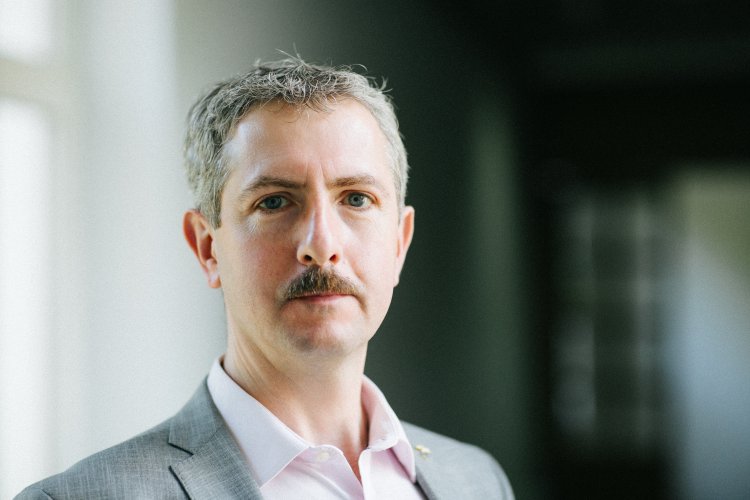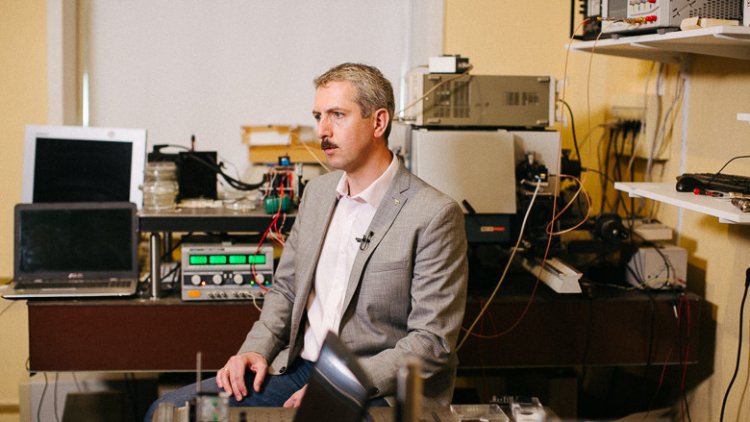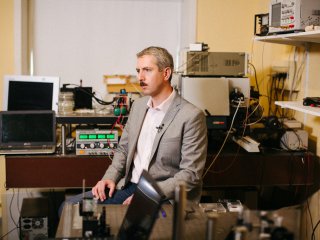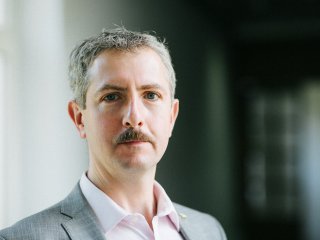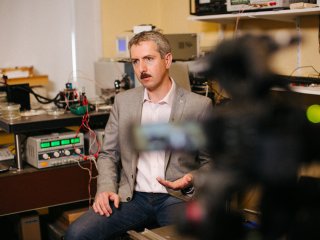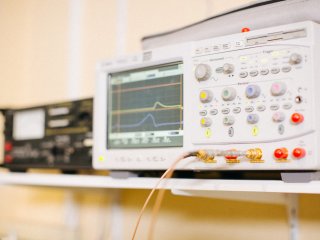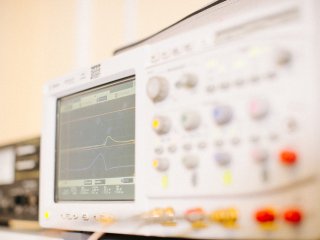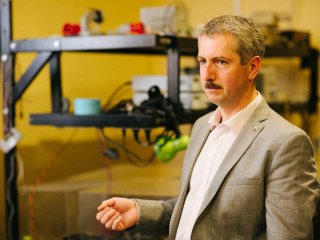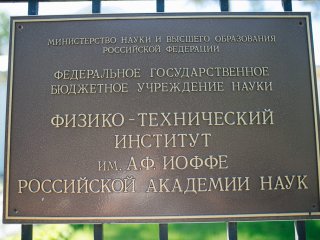Remarkable changes dealing with the use of light take place in the world today before our eyes. One can say that all of us take part in a sort of revolution of light. The use of light for traditional illumination takes a back seat, and it becomes an essential element of technologies instead. To a great extent, it is related to mainstreaming of lasers, semiconductor ones in the first turn. They are used for optical data recording and transfer (both Internet and mobile communication are inconceivable without it). Besides, they are used for processing materials, in metrology, medicine, etc.
What makes semiconductor lasers so unique? How can they change our future? These topics among others are highlighted by RAS professor, chief research fellow at the Ioffe Institute of Physics and Technology Grigory Sokolovsky in the interview to Scientific Russia.
─ What are semiconductor lasers, and where are they used?
─ Semiconductor lasers have made our world such as we see it today. The Internet and mobile communication have become a part of our everyday life thanks to semiconductors and lasers. When we talk on the phone, it seems that our voice is flying through the air. Yet, it is not so. Our voice is flying through the air in the form of electromagnetic waves for the first several hundreds of meters alone. Then it comes to the cell station and is delivered to another cell station, DATA-center and so on via fiber-optical channels. The semiconductor laser is the key element of this system. Without such lasers, there would be no fiber-optical communication, quick communication between continents, modern Internet and modern information society, as it is technically impossible to deliver such a quantity of information to consumer via copper wires.
Thanks to lasers, the world is changing beneath our eyes, and we take part in a sort of light revolution, as light is used today in a way different to the one that our ancestors and even parents used it. At that time, it was used mostly for illumination, while today light becomes an essential element of technologies.
─ Can you quote an example of such use of light that our ancestors did not know about?
─ There are so many of them that we can spend hours quoting such examples. It is, for instance, the transformation of solar light into electric energy, green energetics that bright future is foretold to. One can treat it differently. You may recall the energy output of green energetics which is lower if compared to the one of traditional energy industry (based on burning hydrocarbons), which constitutes a problem. Nevertheless, photo-electricity can, beyond doubts, make a serious contribution to energetics, at least local one, by way of supplying almost each household with electric power. I do not mean heavy consumers like large plants.
Besides, there are positioning or locating systems. We all have got accustomed to GPS. However, local positioning systems are required to supplement them. They are based on the fact that you learn your coordinate and, after GPS signal is lost, you trace its changes with the help of gyroscopes and accelerometers. Such systems are based on the use of light and lasers. In general, people knew gyroscopes and accelerometers long before the invention of lasers. However, it is the use of lasers that allowed for making these devices very compact.
─ Semiconductor lasers experience a serious boom today. They drive all other lasers out of the market. What is the reason?
─ The reason lies in the fact that semiconductor lasers are the only ones that get pumped up directly by electric current, while all other lasers need some light to do it. In semiconductor lasers, both electrons and holes are directly transformed into laser light. This property makes a semiconductor laser more effective than any other kind of laser. The production of semiconductor lasers accounts for a half or slightly less than half of the whole laser industry. This figure is changing from one year to another, but we can say that semiconductor lasers account for almost a half of all lasers in terms of cost. Naturally, the major part of all semiconductor lasers is used in the field of telecommunications, i.e., the Internet and fiber-optical communication in general.
─ Where else are lasers used, apart from telecommunications?
─ This question probably excludes unambiguous answer. Yet, I would put the processing of materials first, as processing materials using lasers including 3D printing has come to a new, I would say, fantastic level.
Light can be used not only for illumination, but for cutting and welding as well. Laser cutting, welding and drilling make it possible to obtain results that fundamentally unattainable in case we use traditional mechanical methods of processing materials. Moreover, this process becomes quicker, cheaper, and more accurate year after year.
The heaviest use of lasers is observed in the field of healthcare. Quoting all areas of use for lasers will take a lot time. Along with laser knife or surgical laser that everybody knows of, there are a lot of diagnostic methods which let a physician see what cannot be seen when other methods are used. Moreover, they see it directly during the surgical operation that allows for relieving the patient’s suffering and prolonging their life.
─ What is the capacity of lasers that modern science can boast of?
─ In case of lasers, it is better to speak in terms of capacity range – from single photons used, for instance, in quantum cryptography, to lasers with terawatt capacity (these are desktop machines) and petawatt capacity. In the near future, exawatt lasers are to be issued. Naturally, these are huge machines capable of producing thermonuclear fusion and achieving power density that will create conditions comparable with the ones in neutron stars.
Laser beam is different from the one of sun and electric lamp, as the photons in it are identical from the viewpoint of quantum mechanics: they cannot be distinguished from each other. That is why it is easy to bring a laser beam into focus. This opportunity allows for achieving very high power density. Thus, a scientist working at a laboratory can create conditions comparable with the ones in neutron stars. Naturally, it should be a large laboratory, yet such a result is attainable today nevertheless.
─Are such developments in demand by the Russian business?
─ You know, all these phrases about hydrocarbon damnation, Dutch disease and oil dependency that we often hear are true for Russian business. The fact is that the economists have justly believed for a long time that if the country had such large reserves of subsoil resources, they could be turned into money and used to buy high-tech products. Thus, they decided to limit the economy to extracting mineral resources or probably the primary processing of them and give the products away to the countries where the industry is more developed without developing their own one.
This decision has played a dirty trick on us. When it turned out that global economy is not an eternal thing and can be multiplied by zero with one stroke of the pen, it became clear that the country needs industry of its own. However, it is impossible to build industry in a flash. As for science, one can keep it on short rations for some time. After the financing is resumed, it starts recovering quickly enough. However, such methods cannot be used for industry, as it has a longer cycle of development. Thus, we cannot say about the symbiosis of science and business today. Naturally, the authorities push us towards this symbiosis. Moreover, the scientists are ready to move in this direction, yet business is not ready. It is hard for business to switch over from retail to longer investments, as businessmen believe this way to be economically inefficient. It is much easier to buy and sell – the risks and costs are clear. When the investments are to pay off in ten or even more years, businessmen wonder what they should do it for.
─ Does the Ioffe Institute specialize in semiconductor lasers?
─ The Ioffe Institute can boast of a broad enough scope of research probably covering all areas of modern physics. Yet, if we take lasers, I would say that, yes, the Institute is a champion in semiconductor lasers. It created the first such lasers in the world! I can say that our institution is a cradle of semiconductor lasers.
Naturally, we produce many different kinds of lasers for data transfer and processing, some industrial applications and other areas. Using lasers, one can monitor the weather, measure distances and make many other interesting things.
Winner of Nobel Prize J.I. Alfyorov held the position of director at the Ioffe Institute over the period from 1987 to 2003. The scientist won the Nobel Prize in physics in 2000 for the “development of semiconductor heterostructures used in high-frequency and optical electronics.” Since 1960s a group of scientists under the guidance of J. Alfyorov had covered the way from creation of the first ideal heterogeneous junctions and achievement of continuous generation mode for semiconductor lasers at room temperature to development of technology and design of powerful lasers and creation of semiconductor lasers on the basis of quantum dots.
─ Can you highlight your work at the Ioffe Institute in detail?
─ Today, my colleague and I deal with research of the so-called quantum cascade laser. They are fundamentally different from all other semiconductor lasers generating the beam not at the expense of the electron recombining with the hole, i.e., passing from the conductivity zone to valence band, but due to the fact that electrons cross over among the levels of size quantization in quantum wells. Quantum wells are thin layers of semiconductor with low width of forbidden region inside the layers with high width of forbidden region. As the layers are very thin, the electrons cannot hold any energy position inside such a thin object, according to the laws of quantum mechanics, and so their energy is quantized.
In 1971 employees of our institution Robert Suris and Rudolf Kazarinov decided to make a set of such quantum wells to generate the laser beam due to the fact that the electron would jump from one level to another in these quantum wells. To do that, high voltage should be fed to the structure consisting of quantum wells. Therefore, the electron will jump down the steps of this sort of staircase generating photons. As far as traditional lasers are concerned, the ultimate dream of any scientist is 100% quantum output, i.e., each electron generates a photon. Here, there are a lot of quantum wells, so we can get the quantum output of 200%, 1200% or even more. This discovery had become an outstanding Soviet know-how (by the way, Robert Suris still works at the Ioffe Institute and we are happy about it). However, it was too early to speak about quantum wells in early 1970s, like talking about flight to the Moon at the time of Tsiolkovsky. That is why the first lasers of this type were produced only in mid-1990s. Even now, this technology is very complicated. We have mastered it and recently even set the record of power on one of wavelengths, i.e., on wavelength of 8 microns. However, we have a lot of technical problems and new achievements ahead. What are these lasers required for? They are especially good for generation of beam in medium and far infrared band. Very many lines of absorption as to different gases and substances in condensed state are located in this very band. It is very interesting to watch these absorption lines. One can see what kind of substance or even group of substances is in front of them. Without exaggeration, this technology allows for feeling the smell remotely with the help of one’ own eyes!
G. S. Sokolovsky made a serious contribution to development of domestic nano-photonics and semiconductor laser optics. The laser designs developed by him allow for raising substantially the yield ratio in production and dramatically improving the spectrum and power characteristics of lasers. He was the first to demonstrate the generation of Bessel beams produced by semiconductor lasers and photon-emitting diodes and show the possibility of super-focusing the beam of powerful semiconductor lasers. He was the first to demonstrate the enhancing the femtosecond optical impulses with the help of semiconductor amplifiers and suggest the method for escalation of signals in semiconductor lasers, as well as obtain the picosecond optical impulses at direct current pumping.
Reference Source: Information portal of RAS professors. Photo: Andrey Luft / Scientific Russia
─ How can laser technologies change the world in the near future in general?
─ New surprising horizons and opportunities are being opened for us. Especially it is true for business. The simplest innovation that we can see today lies in laser headlights for cars. If you like beautiful cars, look at BMW i8. The model has laser headlights. What advantage does it offer? First, such headlights are extremely bright, so the beam can reach out to a twice longer distance than the one of standard xenon ones. Second, they offer the possibility of putting out separate parts of direction diagram not to disturb the drivers of car moving in the opposite direction. It means that you see the road well, yet do not bother the drivers of other cars thus raising the traffic safety and comfort. Today, Audi and other manufacturers do the same. By the way, the laser chip used for such illumination looks almost the same as a standard light-emitting diode. In the future, lasers can change the road and architectural illumination completely.
At present, the lampposts are not so high and relatively densely installed on the road, because they have inherited the logic of standard incandescent lamps, which are now replaced by light-emitting diodes. Due to their dimensions and properties of light, incandescent lamps project their light on a round or oval area, not line. As for laser illumination, one can form of light projection to their own liking. There are almost no restrictions, and you can install very high lamppost illuminating only the required area. It is interesting that the laser can be installed not at the top, but at the bottom of the lamppost with fiber-optic channel gong to the top and emitting light. One can hardly imagine such a laser to get broken, as its lifetime can be 100,000 hours and even more. However, if something still goes wrong, you just unscrew the lid at the bottom of the lamppost, replace the laser, and the illumination is back here!
There is one more wonderful innovation related to data transfer – the so-called Li-Fi. We have got accustomed to Wi-Fi using it every day. Li-Fi is the same, yet light serves as the carrier frequency instead of radio signal. I mean the light modulated so that it is capable of transferring information. Naturally, we cannot see this modulation with our own eyes. The light modulated at the frequency of, say, 1Ghz is out of human view, yet quite suitable for data transfer. Just imagine a lamppost securing Internet access with the help of light, or the traffic light capable of informing the driver about traffic jams, etc.
─ Such technologies seem incredible so far…
─ What about pilotless vehicles? Don’t they seem incredible to you? Jut visit California, and you will see many such cars on the road. The only reason behind the absence of such vehicles in Russia lies in the present legislative base. The law valid in many countries including our one says that the driver who has run into the other car is to blame. Who is the guilty party, if the car is pilotless? Naturally, the manufacturer is. That is why the manufacturers are against such a scenario, as they run the risk of going bankrupt due to the obligation to pay fines and expenses of traffic accident victims. Nevertheless, there is no doubt that such vehicles will appear on our roads very soon. Along with the respective legislation, we need the development of machine vision and LIDARs (laser radars) to let the car know what happens on the road. Many technologies that seem inconceivable today may turn into reality tomorrow. That is why I am sure that semiconductor lasers will find application in various areas of our everyday life increasingly more often.
The interview was taken with the support of the Ministry of Science and Higher Education, as well as the Russian Academy of Sciences
